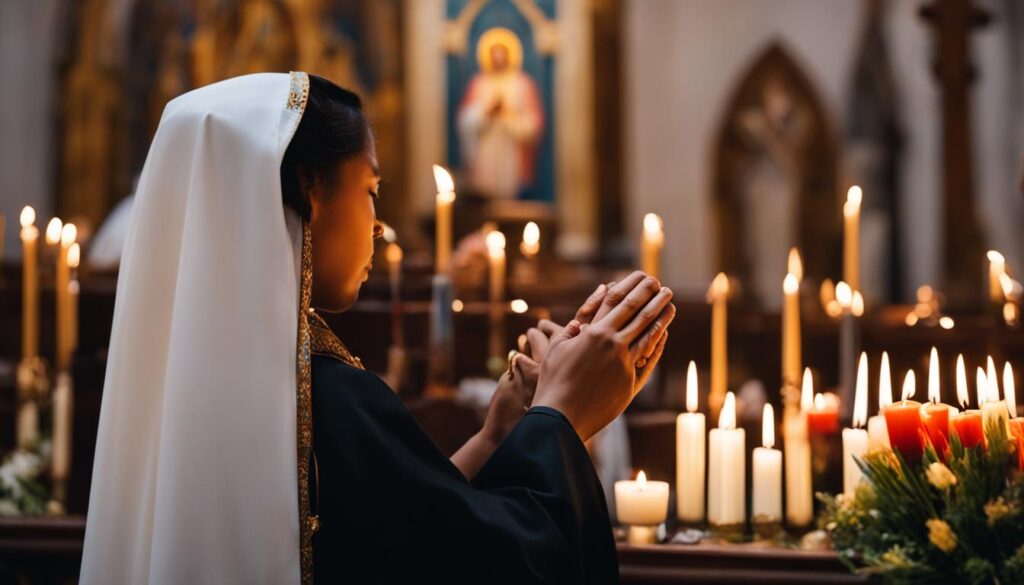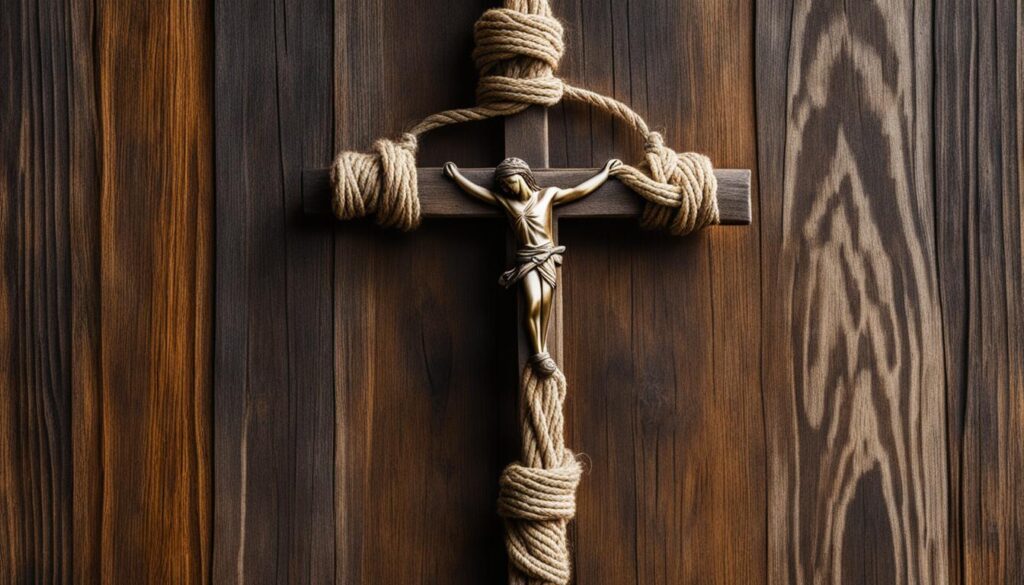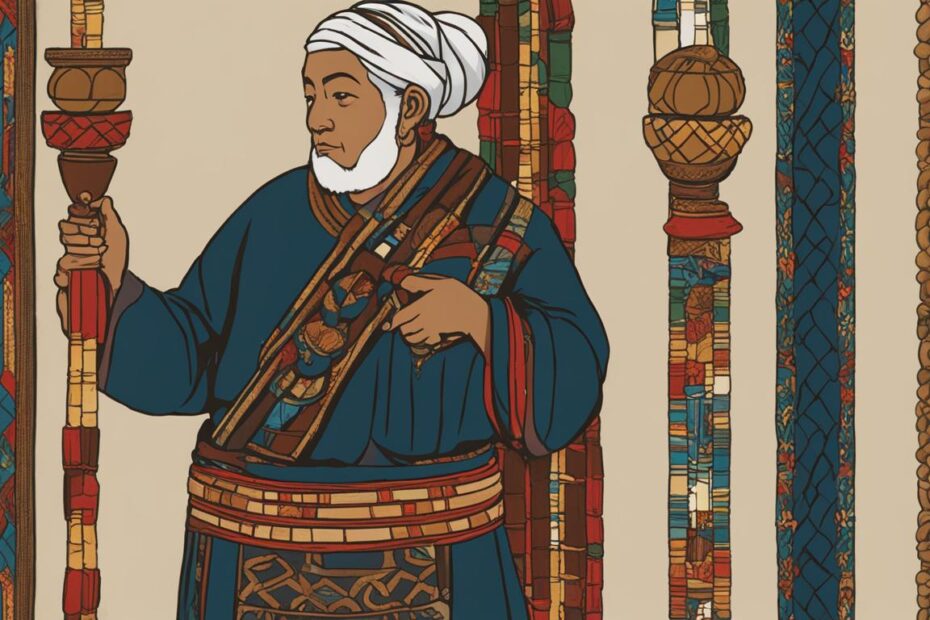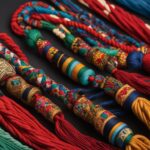Discover the rich history and origins of prayer ropes, an enduring symbol of devotion in Orthodox Christianity. Through the centuries, these sacred objects have evolved in design and materials, serving as a tool for prayer and meditation. Let’s delve into the fascinating story behind the prayer rope and its significance in personal spiritual life.
From the early days of Orthodox Christianity, prayer ropes have been utilized as a means to count prayers and aid in deepening one’s connection with God. The history of prayer ropes can be traced back to the Desert Fathers, who would use ropes made of palm leaves as they diligently recited their prayers. Over time, these simple ropes evolved into the intricate prayer ropes we know today, carrying deep spiritual significance.
Key Takeaways:
- The history of prayer ropes dates back to the early days of Orthodox Christianity.
- Prayer ropes have evolved in design and materials over centuries.
- They hold great significance in Orthodox Christianity as a tool for counting prayers.
- The symbolism behind prayer ropes represents the believer’s journey in prayer.
- Using a prayer rope is a simple practice that fosters peace and connection to God.
The Evolution of Prayer Ropes
Through the years, prayer ropes have evolved in design and materials. In ancient times, prayer ropes were made of simple materials like palm leaves or woven threads. These early prayer ropes were often plain and unadorned, reflecting the simplicity of the early Christian communities. Over time, the design of prayer ropes became more intricate, with the addition of beads or knots.
Traditional prayer ropes are typically made of wool or silk and consist of knots or beads in specific patterns. These patterns can vary depending on the tradition or region, but they all serve the same purpose – to aid in counting prayers. Each knot or bead represents a prayer, allowing the individual to keep track of their devotional practice. The use of specific patterns also adds a symbolic element to the prayer rope, deepening its spiritual significance.
Prayer ropes have evolved from simple ropes made of palm leaves to intricate designs with beads or knots.
Throughout history, prayer ropes have remained a cherished tool for prayer and meditation. While the materials and designs may have changed, the purpose of the prayer rope remains the same – to assist the believer in their spiritual practice. The evolution of prayer ropes is a testament to the enduring nature of faith and the human desire to connect with the divine.
| Time Period | Materials | Design |
|---|---|---|
| Ancient Times | Palm leaves, woven threads | Simple, unadorned |
| Middle Ages | Wool, silk | Knots, beads |
| Modern Era | Various materials | Various designs |
The table above showcases the evolution of prayer ropes through the years. From the simple ropes made of palm leaves in ancient times to the more intricate wool and silk ropes adorned with knots and beads in the Middle Ages, prayer ropes have adapted to the needs and aesthetics of different eras. In the modern era, prayer ropes can be found in a variety of materials and designs, reflecting the diversity of spiritual practices and traditions.
The evolution of prayer ropes is a reminder that while traditions may change, the power of prayer remains constant. Whether simple or ornate, prayer ropes continue to serve as a tangible tool for believers to deepen their connection with the divine.
The Significance of Prayer Ropes in Orthodox Christianity
Prayer ropes hold great significance in Orthodox Christianity. They are not just a simple tool for counting prayers, but rather a physical representation of an individual’s commitment to their faith and a means of deepening their connection with God. The history and use of prayer ropes in Orthodox Christianity can be traced back to the early days of the Desert Fathers, who used ropes made of palm leaves to aid in their daily prayers.
Using a prayer rope helps to bring focus and stillness to the mind, enabling individuals to enter into a state of prayer and meditation more easily. The knots or beads on the prayer rope symbolize the prayers being offered, allowing believers to keep track of their progress and maintain a consistent prayer practice. Each knot or bead represents a prayer, making the act of using a prayer rope a tangible reminder of the individual’s devotion and commitment to their spiritual journey.
Furthermore, the act of using a prayer rope, particularly in the repetition of the Jesus Prayer, is a way to cultivate a sense of peace and connection to God. The repetition of the prayer allows individuals to enter into a rhythmic pattern, creating a meditative state that brings a sense of calm and spiritual focus. The prayer rope becomes a physical anchor, grounding the believer in their faith and helping them to navigate the challenges of life through prayer.
The Historical Significance of Prayer Ropes
“The history of prayer ropes in Orthodox Christianity dates back to the early days of the Desert Fathers. It is a practice that has been passed down through the generations, continuing to play a vital role in the spiritual lives of believers.”

| Symbolism of Prayer Ropes | Meaning |
|---|---|
| Circular Design | Represents eternity and the never-ending cycle of prayer |
| Knots or Beads | Symbolize the prayers being offered and serve as a physical reminder to stay focused on prayer |
| Cross | Represents the sacrifice of Jesus and acts as an anchor for the believer’s faith |
Prayer ropes continue to hold a prominent place in the personal spiritual life of believers, serving as a tool for devotion, meditation, and connection with God. They provide a tangible link to the rich historical traditions of Orthodox Christianity, representing a timeless practice that continues to resonate with believers today.
The Symbolism Behind the Prayer Rope
The prayer rope holds deep symbolism in Orthodox Christianity, representing the believer’s journey in prayer and their connection to God. Each element of the prayer rope carries significant meaning, reinforcing the individual’s devotion and spiritual practice.
Symbolism of the Circular Design
The circular design of the prayer rope represents eternity and the never-ending cycle of prayer. Just as the rope has no beginning or end, prayer is seen as a continuous conversation with God, transcending the boundaries of time and space. The circular shape also symbolizes the unity and interconnectedness of all believers, emphasizing the communal aspect of prayer within the Orthodox tradition.
The Significance of Knots or Beads
The knots or beads on the prayer rope hold great symbolism as well. Each knot or bead represents a prayer that has been offered. As the believer moves their fingers along the rope, they are reminded of the prayers they have already said, keeping them focused and present in their devotional practice. The physical act of touching each knot or bead also helps to anchor the mind and bring a sense of rhythm and peace to the prayer experience.
The Cross at the End
The cross at the end of the prayer rope serves as a powerful symbol of Christ’s sacrifice and the ultimate act of love. It acts as an anchor for the believer’s faith, reminding them of the central teachings of Christianity and their personal relationship with Jesus. The cross also represents the victory of life over death and the hope of salvation through Christ.
In conclusion, the symbolism behind the prayer rope is rich and profound, encompassing themes of eternity, unity, devotion, and salvation. It serves as a tangible reminder of the believer’s commitment to their faith and provides a physical tool to aid in prayer and meditation. Through the use of knots, beads, and the cross, the prayer rope helps believers deepen their connection with God and cultivate a sense of peace and spiritual growth.
| Symbolism | Meaning |
|---|---|
| Circular Design | Represents eternity and the never-ending cycle of prayer |
| Knots or Beads | Each represents a prayer offered and helps to keep the believer focused and present |
| The Cross | Symbolizes Christ’s sacrifice, anchors the believer’s faith, and represents hope of salvation |
How to Use a Prayer Rope
The prayer rope is a beautiful and powerful tool that can enhance your prayer and meditation practice. Learning how to use a prayer rope is simple and can bring a sense of peace and focus to your spiritual life. Here are the steps to effectively use a prayer rope:
Step 1: Hold the Prayer Rope
Start by holding the prayer rope gently in one hand, allowing it to rest comfortably. Take a moment to center yourself and prepare for prayer.
Step 2: Recite the Jesus Prayer
Begin reciting the Jesus Prayer, such as “Lord Jesus Christ, Son of God, have mercy on me, a sinner.” As you say each prayer, move your fingers to the next knot or bead on the prayer rope.
Step 3: Maintain a Rhythm
Continue reciting the Jesus Prayer and moving your fingers along the prayer rope. This rhythmic movement can help to create a sense of peace and calm as you focus on your prayers.

Step 4: Count Your Prayers
As you move along the prayer rope, you can count your prayers. This can be especially helpful if you have a specific goal or intention for your prayer practice. Take note of how many knots or beads you have moved through to keep track of your progress.
Using a prayer rope can be a deeply meaningful and personal practice. It allows you to engage both your mind and body in prayer, creating a sense of connection and devotion. So take the time to learn how to use a prayer rope and experience the spiritual benefits it can bring to your life.
The Role of Prayer Ropes in Personal Spiritual Life
Prayer ropes hold a deep spiritual significance in the personal spiritual life of believers. They serve as a physical tool to aid in prayer and meditation, providing a tangible reminder of one’s commitment to their faith. The act of using a prayer rope can bring a sense of peace and stillness to the mind, allowing for a deeper connection with God.
Using a prayer rope is a personal and intimate practice that helps cultivate a sense of devotion and spiritual growth. The repetitive nature of counting prayers with the prayer rope creates a rhythm that allows individuals to focus their thoughts and intentions on their spiritual journey. It serves as a guide, helping believers navigate their personal relationship with God.
Just as the knots or beads on the prayer rope symbolize the prayers being offered, the prayer rope itself symbolizes the believer’s journey in prayer. It is a physical representation of the never-ending cycle of prayer and the believer’s commitment to their faith. The cross at the end of the prayer rope serves as a reminder of the sacrifice of Jesus and acts as an anchor for the believer’s faith, grounding them in their spiritual practice.
Overall, prayer ropes play a vital role in the personal spiritual life of believers. They provide a means of connecting with God, fostering a sense of devotion, and deepening one’s spiritual journey. While its use may vary among individuals, the prayer rope remains a powerful tool for prayer and contemplation, guiding believers in their pursuit of a closer relationship with the divine.

Conclusion
The evolution of prayer ropes throughout history is a testament to the enduring nature of faith and the human desire for connection with the divine. From their humble beginnings as simple ropes made of palm leaves to the intricate prayer ropes we see today, they have played a vital role in the spiritual lives of believers.
The prayer rope has adapted and evolved, incorporating new materials and designs, while maintaining its fundamental purpose as a tool for prayer, devotion, and deepening one’s relationship with God. It continues to serve as a tangible reminder of an individual’s commitment to their faith and provides a physical aid for prayer and meditation.
As believers hold a prayer rope in their hands, reciting the Jesus Prayer and moving their fingers along the knots or beads, they enter a rhythm of devotion and find peace and stillness in their hearts. The repetition of prayer and the physical act of using the prayer rope help to create a sense of focus and connection with God.
In conclusion, the prayer rope is not only a symbol of the believer’s journey in prayer but also a tool that has stood the test of time. Its evolution reflects the deep spiritual significance that it holds for believers in Orthodox Christianity and beyond. As individuals continue to seek spiritual growth, the prayer rope remains a treasured companion in their personal spiritual journey.
FAQ
What is the history of prayer ropes?
Prayer ropes have a long history in Orthodox Christianity, dating back to the early days of the faith. They were used by the Desert Fathers as a tool for prayer and meditation, originally made of palm leaves.
How have prayer ropes evolved over time?
Prayer ropes have evolved in design and materials. In ancient times, simple ropes made of palm leaves or woven threads were used. Later, more intricate prayer ropes were created using beads or knots. Traditional prayer ropes are typically made of wool or silk and consist of knots or beads in specific patterns.
What is the significance of prayer ropes in Orthodox Christianity?
Prayer ropes are used as a tool for counting prayers, particularly the Jesus Prayer, and help to focus the mind and bring a sense of peace and connection to God. The knots or beads on the prayer rope symbolize the prayers being offered and each one is a reminder of the individual’s commitment to their faith.
What does the symbolism behind the prayer rope represent?
The circular design of the prayer rope represents eternity and the never-ending cycle of prayer. The knots or beads represent the prayers being offered and serve as a physical reminder to stay focused and present in prayer. The cross at the end of the prayer rope symbolizes the sacrifice of Jesus and acts as an anchor for faith.
How do you use a prayer rope?
To use a prayer rope, hold it in your hand and recite the Jesus Prayer. As each prayer is said, move your fingers to the next knot or bead on the rope. This allows you to count your prayers and stay focused on your devotional practice.
What role do prayer ropes play in personal spiritual life?
Prayer ropes serve as a tangible reminder of an individual’s commitment to their faith and provide a physical tool to aid in prayer and meditation. Using a prayer rope can bring a sense of peace and stillness to the mind, allowing for a deeper connection with God.
Conclusion
The history of prayer ropes is a testament to the enduring nature of faith and the human desire for connection with the divine. From their humble beginnings as simple ropes made of palm leaves to the intricate prayer ropes we see today, they have played a vital role in the spiritual lives of believers. The prayer rope continues to evolve and adapt to the needs of individuals, but its essence remains the same – a tool for prayer, devotion, and deepening one’s relationship with God.








